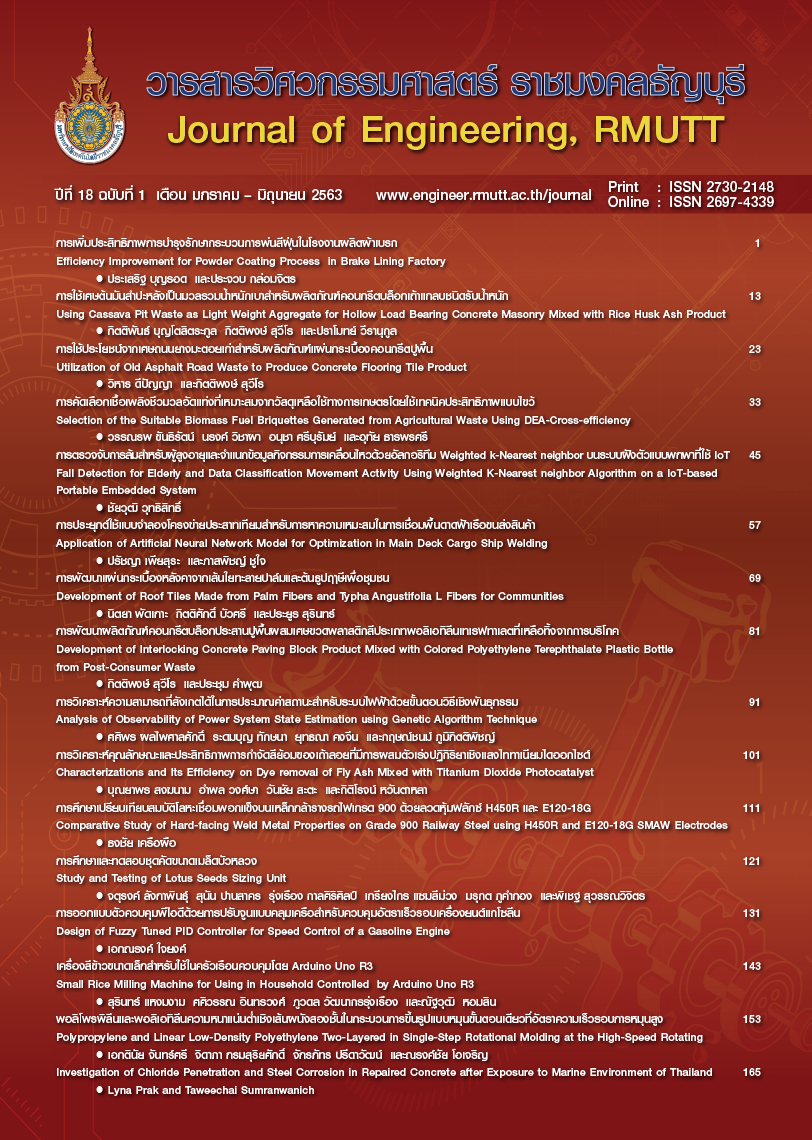การพัฒนาผลิตภัณฑ์คอนกรีตบล็อกประสานปูพื้นผสมเศษขวดพลาสติกสีประเภทพอลิเอทิลีนเทเรฟทาเลตที่เหลือทิ้งจากการบริโภค
Main Article Content
บทคัดย่อ
งานวิจัยนี้มีวัตถุประสงค์เพื่อพัฒนาผลิตภัณฑ์คอนกรีตบล็อกประสานปูพื้นผสมเศษขวดพลาสติกสีประเภทพอลิเอทิลีนเทเรฟทาเลต (PET) ที่เหลือทิ้งจากการบริโภค ออกแบบอัตราส่วนปูนซีเมนต์ปอร์ตแลนด์ประเภท1: มวลรวม (ทรายละเอียด และหินฝุ่น) เท่ากับ 1: 3 โดยน้ำหนัก และแทนที่มวลรวมด้วยเศษขวดพลาสติกสี (ฝาขวด ขวด และฉลากฟิล์มหด) ในปริมาณเพิ่มขึ้น ร้อยละ 5 ของน้ำหนักมวลรวมต่ออัตราส่วน เริ่มจากไม่มีการแทนที่จนกระทั่งมีการแทนที่ด้วยเศษขวดพลาสติกสีมากที่สุดร้อยละ 20 ของน้ำหนักมวลรวม รวม 5 อัตราส่วน ได้แก่ อัตราส่วนปูนซีเมนต์ปอร์ตแลนด์ประเภท1: มวลรวม: เศษขวดพลาสติกสีเท่ากับ 1: 3: 0, 1: 2.85: 0.15, 1: 2.7: 0.3, 1: 2.55: 0.45 และ 1: 2.4: 0.6 โดยน้ำหนัก กำหนดอัตราส่วนทรายละเอียดต่อหินฝุ่น เท่ากับ 0.67 โดยน้ำหนัก และอัตราส่วนน้ำต่อปูนซีเมนต์ (W/C) เท่ากับ 0.5 โดยน้ำหนัก บดย่อยเศษขวดพลาสติกสีผ่านตะแกรงที่มีขนาดช่องเปิด 10 มิลลิเมตร และนำมาผสมกับส่วนผสมตามที่ออกแบบโดยใช้เครื่องผสมคอนกรีต จากนั้นอัดขึ้นรูปด้วยเครื่องอัด ทดสอบคุณสมบัติตามมาตรฐาน มอก.827-2531 และคุณสมบัติอื่นๆ ที่เกี่ยวข้อง ผลการทดสอบที่อายุการบ่ม 28 วัน พบว่า อัตราส่วน 1: 2.85: 0.15 เป็นอัตราส่วนที่เหมาะสมที่สุด โดยสามารถผ่านมาตรฐาน มอก.827-2531 ได้ ทั้งนี้ เศษขวดพลาสติกสีที่ผสมลงในคอนกรีตบล็อกประสานปูพื้นในปริมาณที่เหมาะสม จะส่งผลต่อการดูดซึมน้ำ ความหนาแน่น ความร้อนที่สะสมบนพื้นผิว และต้นทุนการผลิตที่ลดลง คอนกรีตบล็อกประสานปูพื้นที่พัฒนานี้ สามารถนำเศษขวดพลาสติกสีมาใช้ผลิตเป็นวัสดุปูพื้นที่มีความแข็งแรง และเป็นมิตรต่อสิ่งแวดล้อม
Article Details
บทความ ข้อมูล เนื้อหา รูปภาพ ฯลฯ ที่ได้รับการตีพิมพ์ในวารสารแนวหน้าวิจัยนวัตกรรมทางวิศวกรรม ถือเป็นลิขสิทธิ์ของวารสารฯ เท่านั้น ไม่อนุญาติให้บุคคลหรือหน่วยงานใดคัดลอกเนื้อหาทั้งหมดหรือส่วนหนึ่งส่วนใดไปเผยแพร่เพื่อกระทำการใด ๆ ที่ไม่ถูกต้องตามหลักจริยธรรม
เอกสารอ้างอิง
Environmental Research Institute (ERI). Micro plastics [Internet].2018 [cited2018 Dec 10].Available from: http://www.eric.chula.ac.th/download/zwaste/Thon.pdf. (in Thai)
Khamput P, Suweero K. Development of paving block for reducing the exterior surface temperature. Proceedings of the 16th National Convention on Civil Engineering; 2011 May 18-20; Chonburi, Thailand. Bangkok: Mahidol University; 2011. (in Thai)
American Society for Testing and Materials(ASTM). Annual Book of ASTM Standards.Philadelphia: ASTM; 2014.
Thai Industrial Standards Institute (TISI).Thai industrial standard no.827-1988: interlocking concrete paving block.Bangkok: Thai Industrial StandardsInstitute; 1988. (in Thai)
Jindaprasert P, Jaturapitakkul C. Cement,pozzolan, and concrete. 7th ed. Bangkok:ACI Partners with Thailand Concrete Association; 2012. (in Thai)
EdenbaumJ. Plastics additives and modifiershandbook. 1st ed. New York: VanNostrand Reinhold; 1992.
Weeranukul P, Suweero K, Weeranukul I.Utilization of vesicular basalt fragment as aggregate in cement board for knockdown building wall. Journal of Engineering, RMUTT. 2019; 17(1):15-24.(in Thai)
Chawakitchareon P, Nualswan N.Utilization of paper label waste for makinginterlocking concrete paving block by using limestone powder-cement asbinder. The Journal of KMUTNB. 2012; 22(1):99-106.(in Thai)
Arunee N. A study of surface temperature in relation to the mass, color intensity and texture of outdoor paving materials[master’s thesis]. Bangkok: ChulalongkornUniversity; 1995.(in Thai)
Ministry of Commerce (MOC). Economic and trade indices database (ETID)[Internet]. 2019 [cited 2019 Mar 25]. Available from: http://www.indexpr. moc.go.th/price_present/tablecsi_month_region.asp?ddmonth=03&DDYear=2562&DDProvince=10&B1=%B5%A1%C5%A7. (in Thai)


